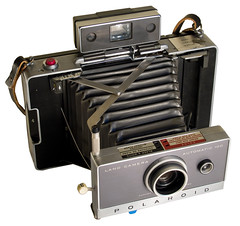Difference between revisions of "Polaroid Land Model 100"
m (→Links: invalid link) |
m (the 240 is actually a virtual equivalent of the 100) |
||
| Line 13: | Line 13: | ||
* 3 element glass lens (114mm f8.8) | * 3 element glass lens (114mm f8.8) | ||
| − | The 100 was produced from 1963 until 1966 (when it was replaced by the [[Polaroid Land Model 250|250]]), retailing on release for $165. | + | The 100 was produced from 1963 until 1966 (when it was replaced by the 240, though the [[Polaroid Land Model 250|250]]), retailing on release for $165, with the Zeiss-Ikon finder, would prove far more popular than the 240. |
== Links == | == Links == | ||
Revision as of 03:32, 7 August 2010
The first model in the 100-400 series of folding rangefinder Polaroid cameras, the Polaroid Automatic Land Camera Model 100 has a set of standard features that are shared by all following models in this range:
- Folding Bellows
- Automatic Exposure
- 100-series Packfilm
The 100 also introduced most of the features that would become common across the higher-end models in this range, though it lacks the Zeiss-Ikon designed combination rangefinder/viewer assembly the later models would adopt. Instead it features separate windows for composition and focusing, a style that would become common across much of the mid-tier range of folding Packfilm cameras. The features it has in common with high-end models such as the 250 and 350 are:
- Tripod mount on all-metal body
- Folding optical system, allowing all delicate parts of the camera to be collapsed into cover.
- 3 element glass lens (114mm f8.8)
The 100 was produced from 1963 until 1966 (when it was replaced by the 240, though the 250), retailing on release for $165, with the Zeiss-Ikon finder, would prove far more popular than the 240.
Links
- The Land List - The Land List's article on the 100.
- Polaroid 100 on www.collection-appareils.fr by Sylvain Halgand
- Picture Gallery using Polaroid Land 100-400 Series picturenoise.com
